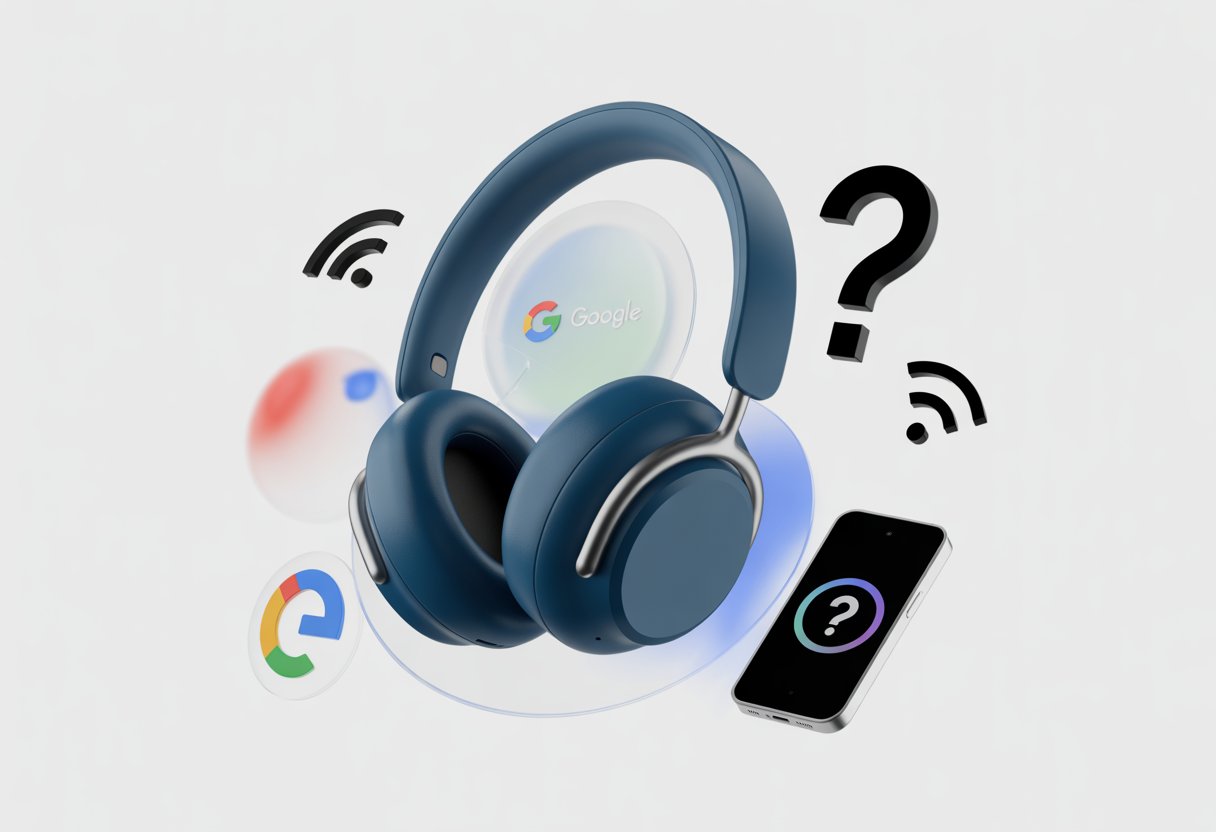Ever tried chatting with Google Assistant through your Bluetooth headphones, only to be met with awkward silence? We’ve all been there, wondering, “Is it me, the headphones, or does Google Assistant just not want to listen today?”
Most Bluetooth headphones don’t support Google Assistant because they’re missing certain built-in features and software compatibility that the Assistant actually needs to work.

It’s humbling when our smart devices aren’t as clever as we hoped. Sometimes, we’ve missed a setting, or our software’s outdated, or maybe the headphones just aren’t on speaking terms with Google Assistant.
If you’re already digging for cables to “fix” Bluetooth, don’t panic—we’ve done the troubleshooting so we can all stop yelling “Hey Google” into the void.
Let’s get into why Google Assistant might be giving us the cold shoulder and what actually helps, according to both experts and other frustrated headphone owners.
Understanding Google Assistant Support in Bluetooth Headphones
Honestly, having Google Assistant whisper in our ears sounds pretty cool. But not every headphone is ready for this sci-fi dream.
Compatibility, features, and trigger words can mean the difference between chatting with our headphones and just talking to ourselves.
What Makes a Headphone Compatible with Google Assistant?
Bluetooth headphones aren’t all best friends with Google Assistant. For our headphones to chat with Google, they need the right hardware and firmware.
Look for the official “Google Assistant built-in” badge. It’s not just marketing—turns out, it’s a real thing that matters.
Bluetooth headsets need certain profiles, like Hands-Free Profile (HFP) and Advanced Audio Distribution Profile (A2DP), just to get started. Some models even throw in a dedicated button for summoning Google’s voice assistant—no magic wands, just a gentle press.
A lot of us find out the hard way that having a mic isn’t enough. Without the right support, we end up mashing buttons and hoping for a response, but usually, we’re just pressing our luck.
Want to check if your device is up to the task? You can find more on setting up Google Assistant on headphones.
Key Features Enabled by Voice Assistant Integration
When Google Assistant and our headphones finally become pals, the features are actually pretty handy. We can ask about the weather, get directions, or send texts using just our voices—suddenly, we’re multitasking wizards.
Integrated headphones let us control music playback, adjust volume, and hear message notifications without lifting a finger. Some even read out our calendar events, so our headphones might know our schedule better than we do.
There’s also support for smart home controls, so we can boss around our thermostat while rocking out. But these features only work when the headset really integrates with Assistant.
If we’re missing features, something in our Bluetooth connection or app setup might need a reset. Don’t worry, we’ve all frantically restarted our headphones before, hoping for a miracle.
Check common troubleshooting steps for more help.
The Role of the ‘Hey Google’ Trigger
The magic phrase, “Hey Google,” isn’t just for showing off. For voice activation to work, our headphones need a microphone that’s always listening (not in a creepy way, hopefully).
Some headphones need us to press a button instead if they’re missing this feature. Voice-activated headphones let us call up Google Assistant hands-free, which feels pretty slick.
But if our headphones don’t support the wake word, we might have to settle for button initiation. It’s a little less futuristic, but still beats pulling out our phone every time.
Compatibility with the “Hey Google” trigger usually means updated firmware and the right hardware. Sometimes, a headset just won’t listen, no matter how polite we are.
Make sure your device supports Google Assistant’s standby listening. Not sure? Read more about using “Hey Google” with supported headphones.
Common Reasons Bluetooth Headphones Don’t Support Google Assistant
Sometimes we ask our headphones to chat with Google Assistant, and all we get is silence. It’s not always our fault—sometimes it’s hardware, old software, or even our location or language.
Hardware Limitations and Missing Microphone Features
Let’s be honest, some Bluetooth headphones just can’t handle it. If our headphones don’t have a built-in microphone, Google Assistant can’t hear anything except our sighs.
Even with a mic, some older or budget headphones use cheap microphones that don’t meet Google Assistant’s requirements. Some headphones skip extra buttons or special chips that help trigger Google Assistant.
If our model didn’t include these features from the start, we’re out of luck. Manufacturers save a few bucks, and we lose our helpful digital sidekick.
A quick check of the specs or user manual usually tells us if the headphones are up to the task. If there’s no mention of “voice assistant support,” it might be time to start browsing for an upgrade.
Software Version Mismatches and Outdated Firmware
Updating can be a pain, but headphones get even fussier than our phones. If our Bluetooth headphones have ancient firmware, Google Assistant won’t know what to do with them.
Sometimes, even the Google Assistant app or our phone’s software is the problem. The solution isn’t yelling “Hey Google!” a few more times.
We should check for firmware updates using our headphone app or the support website. Sony headphones, for example, sometimes require us to update both the headphones and the Headphones Connect app before Google Assistant works.
See how to do that on Sony’s support page for Assistant issues.
If our Google Assistant or system software is out of date, it might ignore our headphones like an old ringtone. Keeping everything updated is the only way to keep Assistant paying attention.
Regional and Language Restrictions
Sometimes Google Assistant just won’t cooperate—it doesn’t work everywhere or with every accent. Even if our headphones are top-notch, Google might not support certain languages or regions.
If we’re trying to use Assistant in a country where it hasn’t rolled out, we get nothing but disappointment. Not all languages are invited to this party, either.
Assistant might refuse to work unless our phone system and Google Assistant language settings match and are supported. We should check Google’s official support page to see which regions and languages are actually available.
If we think our setup should work but we keep getting errors, the culprit might just be our location or the language we’re speaking. Sometimes we have to switch the phone’s language or even use a VPN to trick Google into cooperating.
Bluetooth Settings and Pairing Process Troubleshooting
Sometimes it feels like our headphones have a mind of their own. We tweak settings, shout “Hey Google!”—but nothing happens.
Let’s try to get these stubborn headphones to listen for once.
How to Check Bluetooth Settings for Assistant Support
First things first, let’s see if our Bluetooth settings are helping or sabotaging us. Most devices have a spot where we can turn on voice assistants for Bluetooth headphones.
We need to make sure it’s not hiding behind a sneaky toggle. If we open the Google or Assistant app, we should look for “Bluetooth headset” options under voice settings.
Sometimes, ticking this little box is all it takes. If you can’t find this setting, maybe your headphones are just holding a grudge against Google Assistant for some unknown reason.
Not every headset supports it—especially older or budget models. Let’s not ignore the classic “forget and re-pair” move either.
Disconnect, delete the device, then pair again. Yeah, it’s tedious, but sometimes, it really does trick our headphones into playing nice.
For a closer look at which settings might trip us up, check Google and your headphone brand’s instructions. If we’re still stuck, Sony’s support has a pretty good troubleshooting rundown for Google Assistant issues.
Step-by-Step Guide to the Pairing Process
Pairing isn’t just pushing a button and hoping for magic. Here’s a quick run-through:
- Turn headphones OFF, then ON (because electronics love a reboot).
- Open Bluetooth on our phone or tablet and hit “Scan.”
- When our headphones pop up, tap to connect.
If we’ve paired too many times, our list might look like a headphone graveyard. Delete those old pairings for a clean start.
Once connected, watch for prompts on our device. Some phones will ask if we want to enable extra features, like voice assistants—don’t skip those.
If all else fails, try resetting the headphones to factory settings. Sometimes, that’s all it takes to get things working again.
With the right sequence of taps and a bit of patience, most of us can get Google Assistant running on our Bluetooth headphones—unless, of course, our headphones just have a thing for Siri.
Exploring the Voice Assist Function on Different Devices
Our headphones might talk to us in a bunch of ways, but not all of them chat with the same assistant. Some play nicely with Google Assistant, others prefer Amazon Alexa, and a few just give us mysterious beeps.
Distinguishing Between Google Assistant, Amazon Alexa, and Others
Let’s be real—our headphones are like picky party hosts. Some support Google Assistant, while others only roll out the red carpet for Amazon Alexa or a generic “voice control.”
It’s a compatibility contest. Always check what voice assist function your headphones offer.
The product box, official website, or even a peek at the companion app can reveal if Google Assistant is even invited. Sometimes, devices are hardwired for just one assistant.
Switching from Alexa to Google can be as tricky as convincing your cat to take a bath. A comparison table helps spot the difference:
| Headphones Model | Supports Google Assistant | Supports Alexa | Supports Siri/Other |
|---|---|---|---|
| Headphone A | Yes | No | No |
| Headphone B | No | Yes | No |
| Headphone C | No | No | Yes |
Picking the right assistant matters because features like message reading, reminders, and navigation depend on which one we’re using.
Voice Guidance and Feedback Issues
Let’s talk about those mysterious chirps, beeps, and robotic whispers our headphones toss at us. Voice guidance is supposed to help, telling us when we’re connected or when the battery is low.
But sometimes it just leaves us guessing. Problems pop up if the voice guidance isn’t in our language, is barely audible, or simply doesn’t exist.
In some models, we expect a response from Google Assistant and instead get a generic “voice not recognized” or, worse, nothing at all. The fix might be as simple as updating the software, or as tough as accepting our headphones just aren’t that smart.
If we keep running into trouble, checking the device settings or using apps like Google’s Headphones Connect might help. Sometimes the best guidance is actually reading the manual—yeah, we know, nobody wants to do that.
For more troubleshooting tips, check out Google’s support article on fixing Assistant issues with headphones.
Limitations in Specific Headphone Types and Features
Not all headphones can handle Google Assistant like pros. We’re going to run into issues based on things like tiny earbud size or complicated noise canceling features.
Challenges with Earbuds and True Wireless Models
Let’s be honest—true wireless earbuds are like tiny geniuses in our ears. Still, they sometimes fumble with all the fancy features.
A lot of these models skip dedicated buttons for voice assistants. So we end up tapping, squeezing, or just guessing what will get Google Assistant to pay attention.
Battery life also creates headaches. These little headphones need to save power, so sometimes they cut voice features first.
Everything inside those shells—from microphones to Bluetooth chips—needs to work together. If one part isn’t great, Google Assistant might just ignore us.
And let’s not forget when audio cuts out if we walk more than six feet from our phones. Some people notice Bluetooth requests don’t always work when their device is locked, which makes hands-free use feel impossible.
We could try yelling, but honestly, nobody wants to be that neighbor.
Noise Canceling Technology Compatibility
Noise canceling headphones should feel like a spa for our ears, blocking out distractions and letting us ask Google about the weather. But sometimes, the tech gets so focused on silence that it forgets we want to talk, too.
Active noise cancelation uses extra microphones and some software magic. If our headphones are busy staying quiet in airplane mode (well, sort of), the mics might not always pick up “Hey Google” properly.
Some brands even make us turn off noise canceling just to get Google Assistant working right. It’s a little like paying extra for a burger and then being told to take the cheese off ourselves.
Certain models want us to install updates or extra apps before Assistant works with noise canceling. Others just refuse to cooperate.
If you’ve got high-end noise canceling headphones, it’s smart to check Google’s support details or your manufacturer’s info before assuming everything will work together.
Geographical and Language-Based Support Differences
Not everyone on Earth gets the same Google Assistant perks with Bluetooth headphones. Sometimes, our location or language is the real reason for silent headphones.
Supported Countries and Regions
It sounds odd, but Google Assistant isn’t everywhere yet. We wish it was!
Some countries get more Google magic than others. If you’re in the United States, Canada, the UK, or Australia, your Bluetooth headphones and Google Assistant are more likely to play nice.
But if you’re relaxing somewhere Google hasn’t rolled out yet, you might just end up pressing buttons and wondering what’s going on.
A quick look at Google’s official support shows that older Android versions in some places don’t get along with Assistant either.
Many Asian, African, and even some European regions only get partial—or no—Assistant features on headphones. (Check Google’s full support details if you’re curious.)
So, traveling with headphones doesn’t always mean Google Assistant will tag along.
Language Availability and Setting
Language can really trip you up. Google Assistant tends to play favorites with English when you use Bluetooth headphones.
If you try other languages, you might find that some work halfway—or not at all. When your favorite language isn’t on the list, Google Assistant just clams up and ignores you.
Here’s something odd: your phone’s language and your Assistant’s language need to match. Let’s say you set your phone to Spanish but forget to change Assistant—suddenly, you’re talking to a wall.
To actually get a response, you’ve got to set both your phone and Assistant to a supported language. English, French, or German usually work well. You can check the full list in the Google Assistant guide.
Otherwise, you’ll end up waving at your headphones, hoping for a miracle.
- Why do my Bluetooth headphones keep resetting? Solving the Mystery of Rebooting Ears - January 5, 2026
- Is WHOOP Worth It for Runners, Cyclists, and Weightlifters or Just Another Expensive Wrist Buddy? - January 5, 2026
- Best Fitness Trackers Under $200 That Won’t Make Your Wallet Sweat - January 4, 2026






